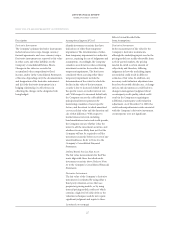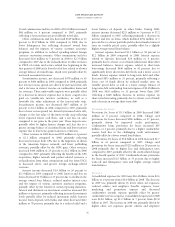American Express 2009 Annual Report Download - page 29
Download and view the complete annual report
Please find page 29 of the 2009 American Express annual report below. You can navigate through the pages in the report by either clicking on the pages listed below, or by using the keyword search tool below to find specific information within the annual report.
2009 FINANCIAL REVIEW
AMERICAN EXPRESS COMPANY
FAIR VALUE MEASUREMENT (CONTINUED)
Description Assumptions/Approach Used
Effect if Actual Results Differ
from Assumptions
Derivative Instruments
The Company’s primary derivative instruments
include interest rate swaps, foreign currency
forward agreements, and cross-currency swaps.
Derivative instruments are reported at fair value
in other assets and other liabilities on the
Company’s Consolidated Balance Sheets.
Changes in fair value are recorded in
accumulated other comprehensive (loss)
income, and/or in the Consolidated Statements
of Income, depending on (i) the documentation
and designation of the derivative instrument,
and (ii) if the derivative instrument is in a
hedging relationship, its effectiveness in
offsetting the changes in the designated risk
being hedged.
identify investment securities that have
indications of other-than-temporary
impairment. The determination of other-
than-temporary impairment is a subjective
process, requiring the use of judgments and
assumptions. Accordingly, the Company
considers several metrics when evaluating
investment securities for an other-than-
temporary impairment. The key factors
considered when assessing other-than-
temporary impairment include the
determination of the extent to which the
decline in fair value of the investment
security is due to increased default risk for
the specific issuer, or market interest rate
risk. With respect to increased default risk,
the Company assesses the collectibility of
principal and interest payments by
monitoring a number of issuer specific
factors, and the extent to which amortized
cost exceeds fair value and the duration and
size of that difference. With respect to
market interest rate risk, including
benchmark interest rates and credit spreads,
the Company assesses whether it has the
intent to sell the investment securities, and
whether it is more likely than not that the
Company will not be required to sell the
investment securities before recovery of any
unrealized losses. Refer to Note 6 to the
Company’s Consolidated Financial
Statements.
Defined Benefit Pension Plan Assets
The fair value measurements for the Plan
assets align with those described under
investment securities above. Refer to Note
21 to the Company’s Consolidated Financial
Statements.
Derivative Instruments
The fair value of the Company’s derivative
instruments is estimated by using either a
third-party valuation service that uses
proprietary pricing models, or by using
internal pricing models, neither of which
contains a high level of subjectivity as the
valuation techniques used do not require
significant judgment and inputs to those
(continued on next page)
Derivative Instruments
In the measurement of fair value for the
Company’s derivative instruments,
although the underlying inputs used in the
pricing models are readily observable from
actively quoted markets, the pricing
models do entail a certain amount of
subjectivity and therefore, differing
judgments in how the underlying inputs
are modeled could result in different
estimates of fair value. In addition, any
necessary credit valuation adjustments are
based on observable default rates. A change
in facts and circumstances could lead to a
change in management judgment about
counterparty credit quality, which could
result in the Company recognizing an
additional counterparty credit valuation
adjustment. As of December 31, 2009, the
credit and nonperformance risks associated
with the Company’s derivative instrument
counterparties were not significant.
27
























